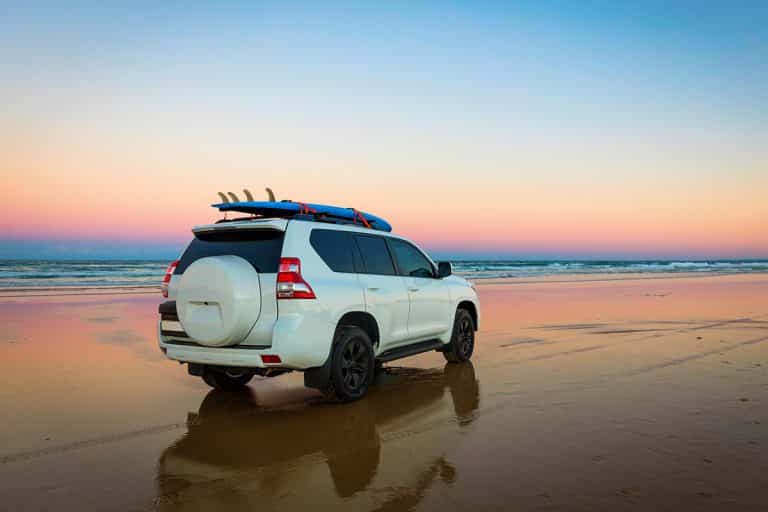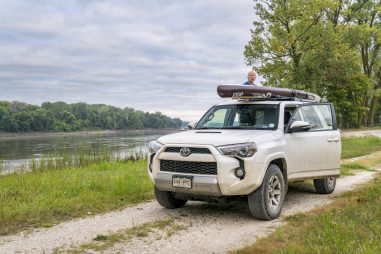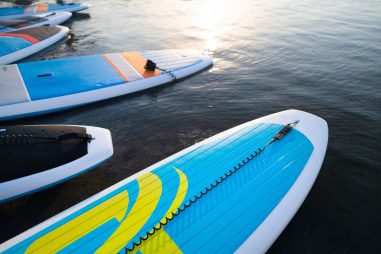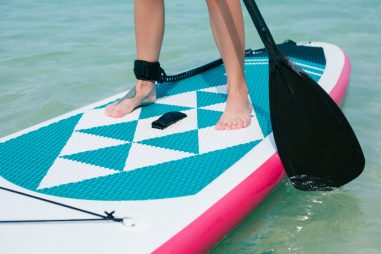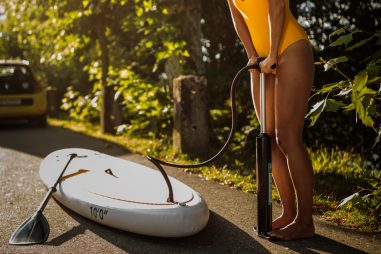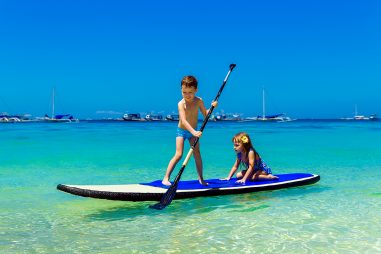When traveling, the ideal location to keep your SUP board is on the roof of your vehicle. Some paddle boarders keep it in the car, which is more complicated and inconvenient. It is also not applicable if you have more than one paddle board. So, a car roof is the way to go. You have two options when it comes to paddle board roof racks: hard racks or soft racks. Of course, mounting the paddle board also varies on the type of car you have. If you have a truck, you can just place it on the truck bed.
How Do You Transport a Paddle Board on a Car?
There are various ways to use a car for transporting a paddle board. You can mount it on the roof of your vehicle, you can attach it to a roof rack, or you can put it inside your car. Choose what is best and appropriate for you and the type of vehicle you drive.
You should also know beforehand the gear needed for you to secure the paddle board safely. The critical thing to note is that whatever transport method you prefer, you must know how to do it properly so that you and your paddle board will be safe.
Will a Paddle Board Fit in My Car?
This depends on the type of car you happen to own or drive. If you use a van or a truck, chances are you can place it inside your car, depending on the size of your vehicle and your seating variation.
If you happen to have a smaller vehicle like a sedan, a paddle board won’t be able to fit inside the car, and you should probably opt to mount your board on the roof so it will not be damaged.
How Do You Transport Multiple Paddle Boards?
You will need a roof rack and a couple of long locking straps to transport multiple paddle boards. Follow the steps below to learn how to mount and strap multiple boards to your car properly.
- Install a roof rack: There are different types of rack systems you can install, so choose the best one for your car and the paddle board you’re using. Most importantly, the roof rack should be able to carry the weight of multiple boards.
- Wrap the long locking straps: Use two 25 foot long (7.5 meters) straps and wrap both of them in the middle of the roof rack. Run them over the hood of the car.
- Load the boards: Now it’s time to load the boards onto the car. When stacking paddle boards, put the biggest boards on the bottom with the fin forward. Stagger the fins and make sure to leave space between boards. Now you have two stacks of boards on the left and right side of the car.
- Secure in place: Once all the boards are in place, it’s time to secure them with the long straps. Adjust the buckle and tighten it to make sure they don’t fall. Do this for both sides, left and right, of the car.
- Tie the left and right side: After securing the left and right side individually, use another long locking strap and join them together.
- Extra measure: If you are going to travel long-distance, make sure to strap the boards again. This time the bands should go inside your car. Doing this will ensure your boards will stay in place just in case your roof rack breaks or one of the outside straps becomes loose.
- Double-check: Once you completed all the steps, go over the straps again and check if they are tightly secured and if the buckles are working properly. If everything seems to be in place, then you are good to go!
How Do You Load a Paddle Board on Top of a Car?
The first thing to consider is the orientation. Paddle boards should be oriented fin up in front of the car. This is a precaution just in case the straps come loose when you are driving, then the fin will catch on the straps before falling off the back of your car.
With the correct orientation in mind, mount the paddle board onto your head and walk slowly to the car’s roof. Lean on to the car and mount the front part of the board (with the fin forward). Then with the board still on your head, walk back to the back side of the board and maneuver the body of the board onto the back area of the car.
How Do You Attach a Paddle Board to a Car?
Roof racks and rails are not standard equipment on many small vehicles like sedans and hatchbacks. Although aftermarket roof racks may be mounted on almost any car, complete roof rack systems can be costly. It’s simple to attach a paddle board to the roof of any vehicle. Soft rack systems may be one of the best solutions for this. These are pretty cheap and come with roof-mounted protection cushions as well as interior-mounted straps to keep your board in place.
Another option is by using foam blocks. Foam blocks generally feature a gripping surface on one side to keep the foam from sliding on the car’s roof and a soft surface on the other to protect your paddle board. Wrap the straps around the paddle board and through the door holes after the blocks are in place and the paddle board is on top. Before closing the car doors, make sure the straps are well tightened.
How Do You Transport a Paddle Board on a Roof Rack?
Many cars now come with built-in roof racks or rails that are meant to install factory or aftermarket crossbars due to the increasing popularity of crossovers and SUVs. If your vehicle has crossbars, you have two options: you can either attach the board directly to the crossbars or use a SUP-specific rack that bolts to the crossbars and includes straps. While SUP racks might save time, they can also be costly, so most people just use the crossbars.
If you do decide to mount straight to the bars, make sure to protect them with padding. Doing this solves two objectives. To begin with, it shields your paddle board from the harsh metal crossbars. Second, it allows your board to sink into the padding, reducing the likelihood of it moving around while you’re driving. Hard foam, branded crossbar pads, and even styrofoam pool noodles, which you can simply cut a split in to slip overtop of the bars, are all possibilities for padding. Set the board on top of the cushioning, making sure it doesn’t dangle too far over the rear of the car. Depending on the length of the board, it might have to extend over your windshield and past the rear bumper slightly, then proceed to attaching the board to the roof rack by using straps.
Can You Put an Inflatable Paddle Board on a Roof Rack?
You can definitely transport an inflatable paddle board by using a rood rack. Thanks to modern-day innovations, inflatable SUPs are stronger and more rigid, and they can be transported while inflated. However, remember that inflatable SUPs are still air-filled boards, and they are more prone to hole and puncture in travel compared to regular paddle boards.
If you are not prepared to take that risk, keep in mind that inflatable SUPs can be folded down and be kept safe in your car. Of course, you’ll have to set up 10 minutes before and after your paddle to inflate and deflate the boar.
Can You Use a Kayak Rack for a Paddle Board?
Using a kayak rack presents no problem at all. Kayak racks are built to support heavier weight and would easily accommodate a standard stand-up paddle board. Because of its sturdiness, it can also accommodate multiple paddle boards with no issue.
How Do I Attach a Paddle Board to a Roof Rack?
To attach your paddle board to the car, grab the buckle and chuck it up on top of the board to secure it. The rest of the strap will be threaded below the crossbar at this point. You’ll throw the extra to the other side after threading it below the crossbar. You should have two straps and two crossbars, so prepare both straps and crossbars while you’re on this side of the car.
On the opposite side, thread the strap underneath the crossbar in the same manner as the other side. Then grasp the very end of the strap and thread it underneath and through the buckle, pushing on the buckle to tighten it up. You’ll have a lot of excess rope depending on how many boards you’re piling on top of your car, so simply knot it together and thread it under so it doesn’t fly around when you’re driving on the freeway, and then do the same thing with the second strap and you’ll be ready to go.
How Do You Attach Two Paddle Boards to a Roof Rack?
This is rarely the case, but you can place the boards side by side if your car has wide crossbars. However, stacking the boards is the most common way. Here are steps on how to do that correctly.
- Load the first board: Place the first board onto the crossbars. Typically, the biggest paddle board is placed at the bottom, so make sure to check the size of the boards.
- Add padding: It is essential to protect the boards from touching each other. To do this, you have to add padding. Pool noodles are most commonly used along with plumbing insulation.
- Stack the second board: Now, you can place the second board atop the insulation. Remember to offset it slightly to make room for the boards’ fins.
- Strap them together: If you know the basics of tying down one paddle board, then you’ve got this in the bag. Secure the boards together tightly by using straps.
Do You Transport a Paddle Board Without a Roof Rack?
As mentioned in the answer above, you can still mount and transport a paddle board to a car’s roof without a roof rack. Some people use a soft rack system, but you can make your own DIY soft rack system if you are on a budget.
- Gather your materials: You will need two foam blocks and two tough straps with buckles for this DIY roof rack.
- Place blocks: Put one block on the front side of the roof and another on the back side of the roof
- Place the board: Next, carefully place your paddle board on top of the foam blocks. Make sure the foam blocks didn’t move, and the board is not placed on the roof of the car.
- Strap it inside the car: Using the long straps, secure the board. One strap should run on the car’s front side from driver’s seat door to the front seat door and the other strap towards the back. Both straps should be strapped inside the car and be secured using the buckle.
- Optional straps: Furthermore, you can use two additional straps to tie the boards to the front and rear bumpers. Doing this makes your paddle board more secure!
How Do You Carry a Paddle Board in a Truck?
Unlike mounting your paddle board to the roof of your car, transporting it via truck is much easier. However, you can’t just put the board in the back of your truck and go on your merry way. You still have to protect your board from rough roads and humps along the way.
To do this, clear your truck bed and place some padding. You can even improvise on what type of padding you will use. As long as it is soft and keeps your board protected, it will do. Depending on the length of your board, you can either lower the tailgate and position the board flat on the padding or keep the tailgate up and place the paddle board diagonally. If you decide to keep the tailgate up, make sure it is also padded so your board won’t be damaged. Lastly, you can use straps to tie down your board. Isn’t that so easy?
Can I Take My Paddle Board on a Plane?
It is possible to bring your stand-up paddle board with you on a plane. Of course, inflatable paddle boards are so much easier to bring since you can just pack them deflated in a suitcase or a bag and check them in as luggage. However, epoxy paddle boards are trickier.
If you’re planning on traveling with your epoxy board, check with your airline first about the length requirements. Make sure your board does not exceed the airline’s limit!
Can You Pull a Paddle Board Behind a Boat?
Many people have tried versions of stand-up paddle board boat tow and SUP wake surfing. SUP wake surfing has a number of advantages over traditional wake surfing and wakeboarding, including the ability to start standing up or even sitting down. Some paddle boarders suggest utilizing a regular wake surf rope and stretching it out to its maximum length of 20 feet. Riders may let go of the rope once they’re comfortable in the wake, precisely like in conventional wake surfing. Most riders will notice a significant difference between regular boards and SUPs while riding the wave. A SUP lacks the agility of a surfboard, but with a bit of practice, most riders will be able to do a wake-to-wake movement and maybe a 360.
And, just as easy as it is to begin, it is just as easy to end. You’re okay to go if you aim the board out of the wake and take a SUP posture. It’s not even necessary to get wet. Boat drivers will note the minor speed differential between a SUP and a boat. However, the average wake surfing speed is 10 to 11 mph; however, for SUP, the speed should be between 11 and 13 mph.
How Much Does It Cost to Ship a Paddle Board?
In the United States, shipping a paddle board varies in price depending on the courier service. They range from $150 – $500. Others quote by weight of the board and give a few choices per pound.
Prices also vary on the overall service. Some companies will offer packing your paddle board for shipping as packing a paddle board takes a long time. It would help if you also took into account insurance.

